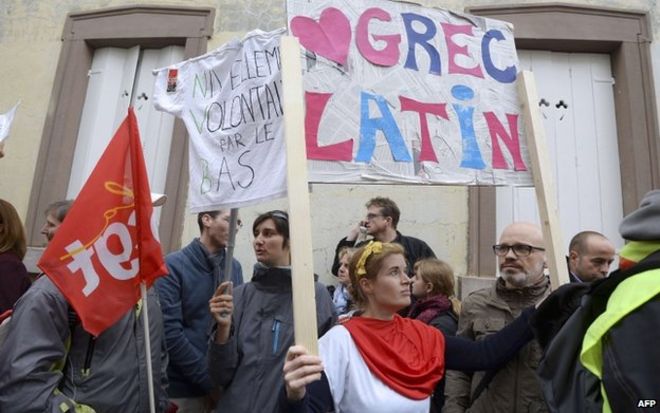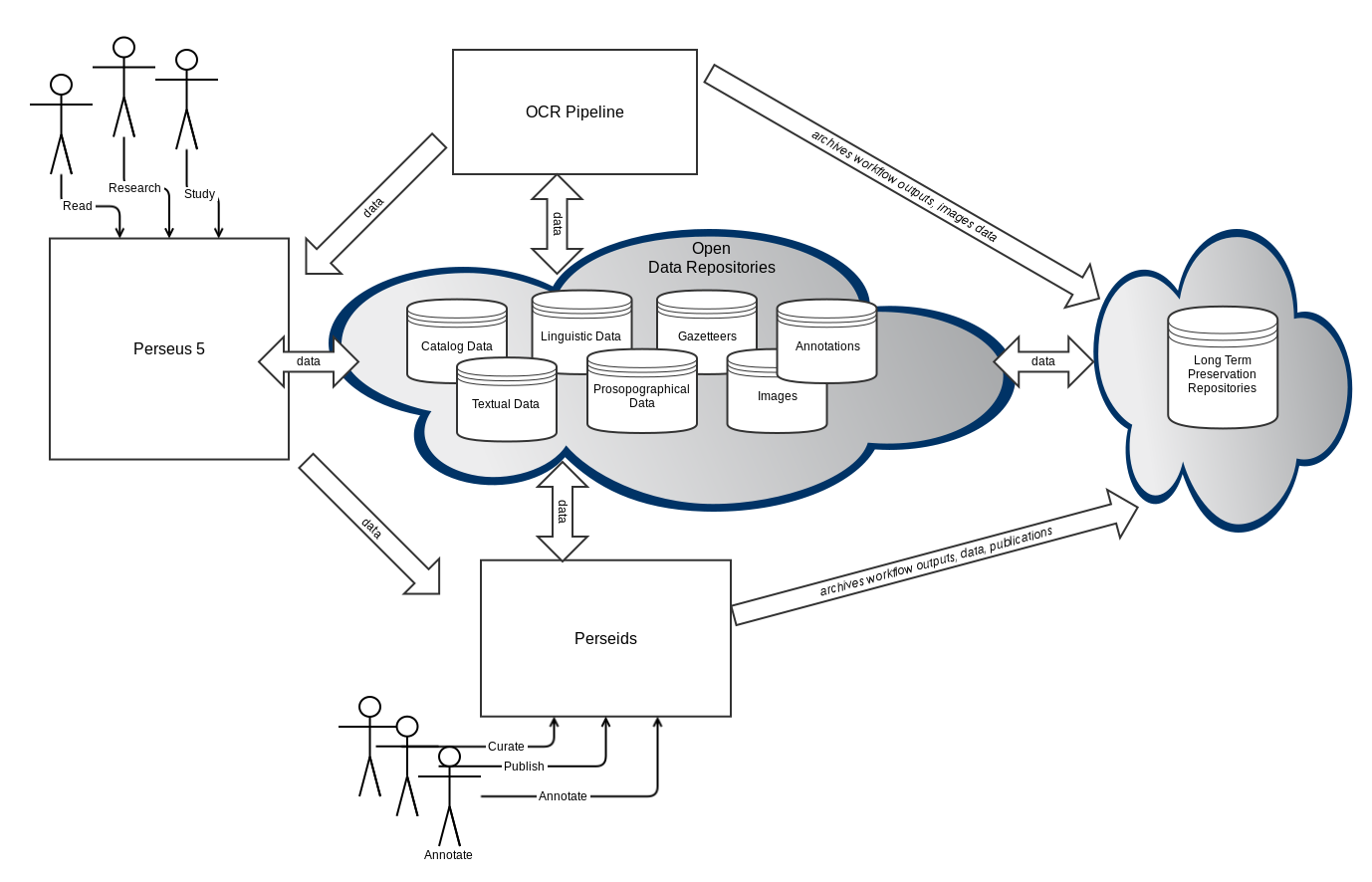Part 2 of 2 (Part 1 is available here.)
Greco-Roman Studies in the US
July 14, 2015
Gregory Crane
gcrane2008@gmail.com
Alexander von Humboldt Professor of Digital Humanities
Leipzig University
Professor of Classics
Winnick Family Chair of Technology and Entrepreneurship
Summary: [The full text is available for comment here.]
I have now released a draft for part 2 of Greek, Latin, and Digital Philology in the United States. This part includes some information about Greco-Romans studies in the US, with some comparisons with the situation in Germany, and then moves on with a very brief and preliminary start for suggestions as how Germany can make itself an (even more) attractive location for a research career in this field.
Tables 20 and 21 address the basic size of Greco-Roman studies in the United States. There were, according to one survey, 276 departments of Classical Civilization in the US in 2012, with 1,410 tenured or tenure track faculty. There are 276 US departments of Classical Civilization, while the 52 universities that have chairs in Greek, Latin, Ancient History or Classical Archaeology would be equivalent to 208 departments (if Germany had the same proportion of universities and had a population of 320, rather than 80, million). But even if we factor in the differing populations, the 200 chairs for Greco-Roman studies in Germany are only equivalent to 800 in a US-sized population, whereas there are 1,410 tenured and tenure-track positions in Departments of Classical Civilization in the US. In absolute terms, the 290 tenure-track positions (presumably assistant professors) outnumber the 200 chairs in Germany. A Professor Doctor in Germany is different, of course, than an Assistant Professor who still needs to earn tenure but the American system offers more points of entry into the tenure system than there are chairs in Germany. There are, I think, a good number of middle level positions in Germany but most of these positions offer a guarantee: after six years, you’re out and you need a new job. Bad as the the long term job market is in the US, it looks a lot better to me when I look closely at the situation in Germany.
Tables 22-25 attempt to identify the business model upon which Greco-Roman studies depends in the United States. Table 22 clearly identifies at least one feature upon which Greco-Roman studies does not materially depend: there are only 1.6 graduating seniors per faculty member (perhaps 5 majors, assuming a few second semester first year students declare per faculty member). Anyone who teaches in a US Department of Classical Civilization knows that larger classes, aimed at non-majors, provide the basis upon which we depend to justify our positions. I have, however, found no statistics on the size of these courses overall — and this deserves a major study if we we want to understand the current health and future prospects of Greco-Roman studies in the US.
At the same time, the Modern Language Association (MLA) (Tables 23-25) provides us with statistics for enrollments in Greek and Latin: there were in fall 2013 still 40,109 students reportedly enrolled in courses of Greek or Latin — 28.4 such students for each of the 1,410 tenured and tenure track positions. We need to be cautious in assessing these numbers — there are almost twice as many institutions that reported enrollments in Greek or Latin as there are departments of Classical Civilization (the MLA states that 512 institutions reported enrollments in Greek and/or Latin but the 2012-13 Survey of Humanities Departments at Four-Year Institutions by the American Academy of Arts and Sciences (AASHD) identified only 276 departments of Classical Studies), but even if we assume that half the students of Greek and Latin are in institutions without departments of Classical Civilization, we get about 15 students of Greek and Latin for every tenured and tenure-track professor. This reflects a discipline-wide commitment to keeping the study of the languages alive.
The MLA numbers also told two stories. First, there was a precipitous drop in enrollments between 2008 and 2013 — about 20% for both Premodern Greek and Latin (when different ways of classifying Premodern Greek are taken into consideration). I think that this surely reflects anxiety about the practicality of undergraduate study after the financial crisis of 2008. Whether we can reverse these losses or whether this is the new normal remains to be seen. But if we consider the figures from 1968 through 2009, we see substantial (to me, amazing) resilience: despite the crises and changes that followed the 1960s, there are about as many people studying Greek and Latin in 2009 as there were in 1968. This was a huge achievement and something for which the study of Greco-Roman culture in the US should take pride. I do think that we will need new ideas and new methods to maintain this resilience but I personally think that we are poised to grow and expand if we are determined, fearless, and judicious. We are poised to reinvent the study of Greek and Latin at every level — but that must remain, for now, an assertion and await another venue for further discussion. More than 75% of all historical language students in the US study Greek or Latin (Table 26) — if smaller historical languages (e.g., Aramaic, Akkadian, Sanskrit, Classical Chinese) are to flourish, the students of Greek and Latin must design a general infrastructure that serves many other languages as well.
Table 27 turns to question of where tenured and tenure-track professors of Classical Civilization in the US got their PhDs. I analyzed the public web pages for 575 US Assistant, Associate, and full Professors in this field. Among 206 faculty at institutions without a PhD program, the national composition was very similar to the Professor Doctors of Greek, Latin, Ancient History, and Classical Archaeology in Germany. In non-PhD departments in the US, 95.6% of the faculty (198 of 206) had US PhDs, while 95% (190 of 200) of the German chairs had PhDs from German institutions. When we considered PhDs from other Anglophone and German-speaking universities, we accounted for 98% of the faculty in both the US (203 of 206) and Germany (196 or 200). If you want to become a Professor Doctor in Germany or a tenured/tenure-track Professor at a non-PhD US program, you had better get a PhD in the US or Germany. You might get one of these positions if you get a PhD in an English-language or German-language program but I would not count on it.
If we look at the departments of Classical Civilization with (by one ranking: http://www.phds.org/rankings/classics) the top-10 PhD programs, we find a very different population. Just under two-thirds of the Assistant, Associate and full Professors in these departments received their PhDs from US programs (64.5%, 102 out of 158 faculty where I could determine the PhD institution) — adding the three Canadian PhDs would get us to almost exactly two thirds (66.5%, 105 out of 158). Thus, fully one third of all these faculty received their highest degree (there was one faculty member who seems only to have received an MA) outside of North America. Most of these (33 out of the overall 158, 21% of the total) came from the UK while two came from Australia.
More than 11% (18 of 158) of these faculty received their PhDs from outside the Anglophone world. With 10 departments, this means that each department has, on average, one or two faculty members who were trained outside the Anglophone world, reflecting a very different scholarly tradition and (often) maintaining deep ties with colleagues in the nations where they were trained. For me, the importance of such international faculty cannot be overstated — when I was a student, I benefited constantly from working with faculty who had not come through the US system. Some may view the fact that fully one third of the faculty at the highest ranked departments do not have US PhDs as a sign of weakness — there are not, in this view, enough good Americans to fill the positions. I see this diversity as a strength of the US system. This strength may only be practical because the highest ranked departments are also the biggest and each can afford to take a chance on one or two faculty who might not necessarily flourish in the US system (I know of at least one instance where a big department brought a big scholar in, knowing he would never fit in — they felt they could afford it).
Table 28 looks quickly at gender balance. The American Academy of Sciences report (from which many of the data are drawn) reports that 40% of the Classical Civilization faculty are women while women accounted for 38% of 582 US faculty members whom I analyzed. The rate for full Professors is lower — 33% — but that 33% is still 50% higher than the 22% of female Professors Doctors in Germany.
The final table (Table 29) summarizes where the faculty I identified got their PhDs. I was most interested in the rates for Assistant Professors — PhD programs have changed substantially since current Assistant Professors chose where to get a PhD, but those departments have changed even more since most Associate and full Professors got their degrees.
The final section provides some partial, preliminary, and perhaps provocative comparisons between Germany and the US in Classical studies. Any student, with a choice of beginning their career in Germany or the US and who can manage either German or English, should consider the following: data reinforces the more general impression that English language scholarship no longer cites non-English scholarship at the same level as even a generation ago; there are more permanent jobs in the US; the most highly ranked departments have between 15 and 22 faculty members and are, arguably, better suited structurally to support a more generalized Altertumswissenschaft; if the student does manage to get a tenure track job (no easy task), then that person immediately becomes a critical member of a(ny rational) department; there is very little evidence that people from outside the German speaking world are going to win one of two-hundred or so coveted chairs in Greek, Latin, Ancient History and Classical Archaeology in Germany.
The full text is available for comment here.


